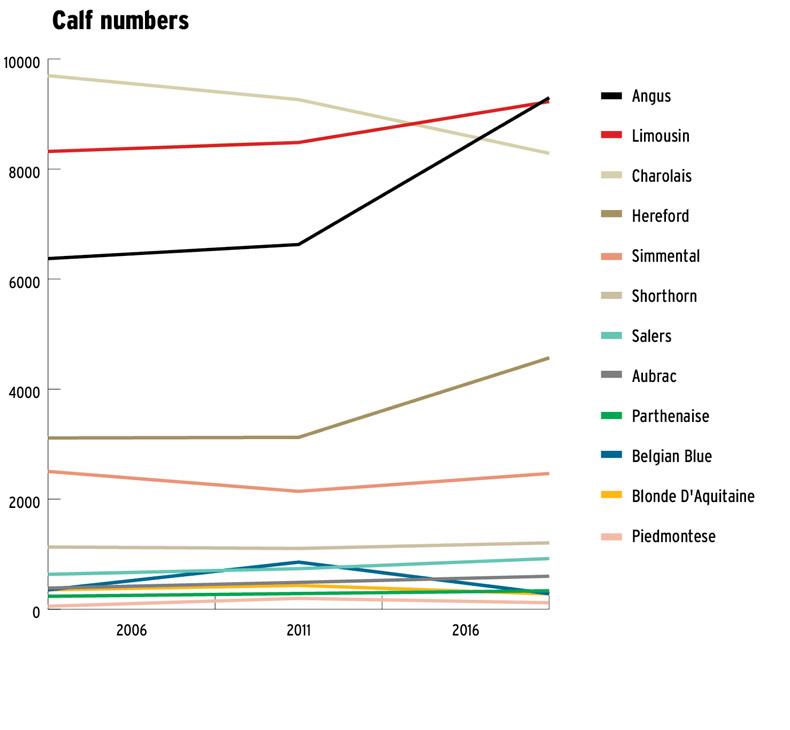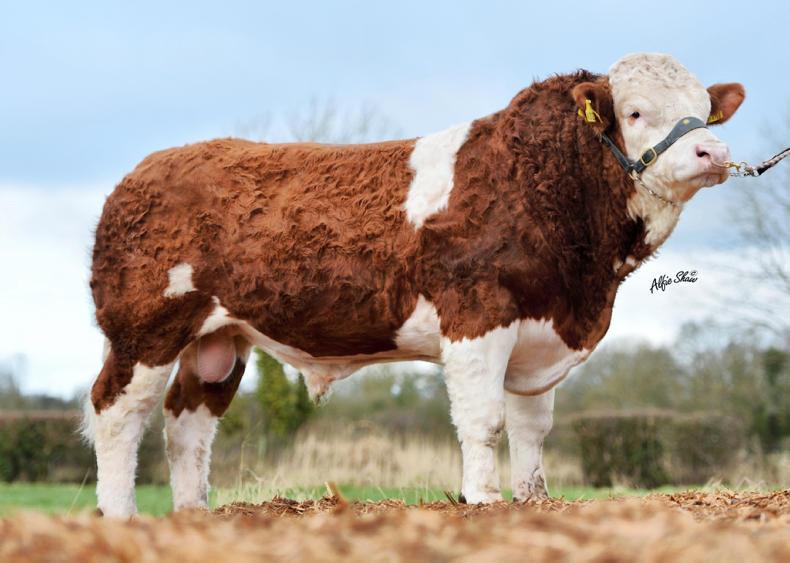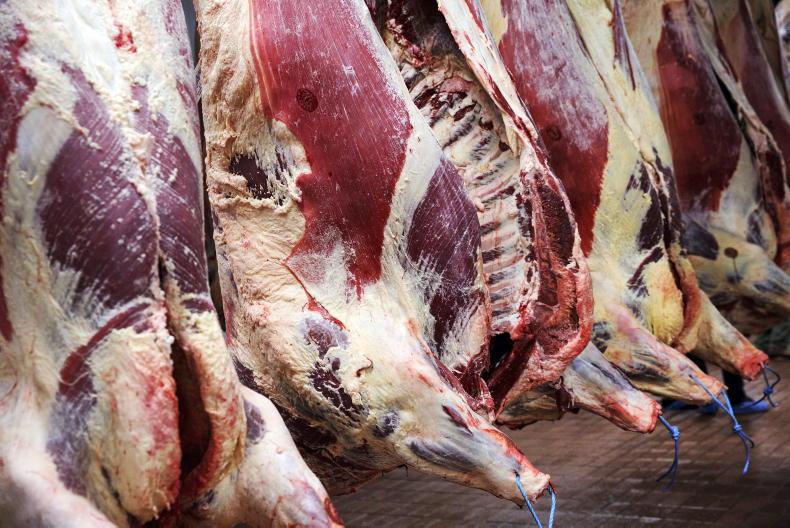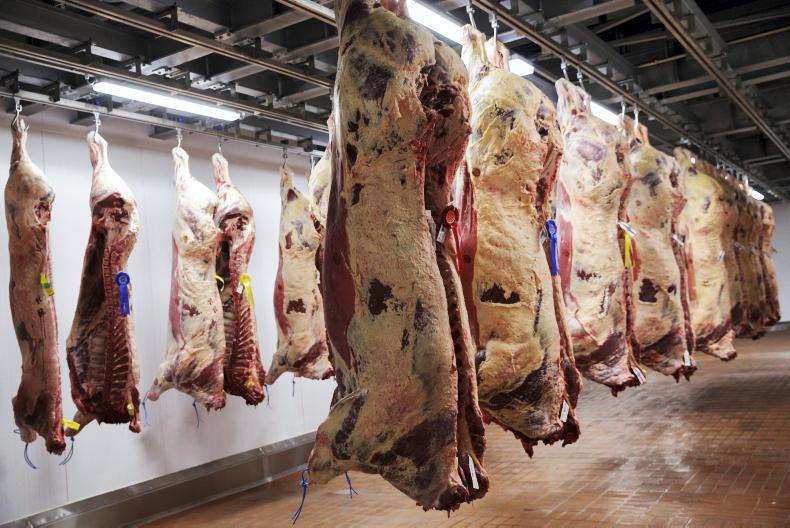As of the end of 2016, Angus has overtaken the Limousin breed on pedigree registrations. This comes after a massive surge in both breeder numbers and birth registrations throughout the last five years.

Registrations for the Angus breed have increased by a massive 45% on 2011 levels to now settle at 9,296 pedigree registrations in 2016. The Hereford breed too saw a similar percentage increase, but on a 2011 base number of just under half of the Angus.
There are a number of key reasons for such a rise in pedigree registrations of traditional breeds in recent years:
Abolition of milk quota in 2015 has led to a noticeable increase in dairy cow numbers, which in turn has led to an increased demand for easier-calving, shorter-gestation bulls. Reputation of the two breeds’ carcase qualities for marbling and taste has also grown massively in recent years. Premium prices for in-spec cattle at factories not only mean dairy producers are getting paid for the calf on the ground but it has also meant the Angus and Hereford breeds have infiltrated a percentage of the suckler market. Export markets all around the EU for breeds such as the Angus and Hereford have flourished over the past number of years. Where once breeders may not have been registering lesser-quality female stock, they now secure a premium price with exporters. The introduction of the Beef Data and Genomics Programme (BDGP) as a way to restore replacement traits in the national herd has led to breeds which have more of a focus on replacement traits benefiting, while other breeds known for terminal traits have witnessed decreased registrations.
While this all looks positive for the traditional breeds, one has to wonder are they growing too fast for the demand that’s out there? The majority of 2016 calves will be sold in 2017 but with over 4,000 extra Angus and Hereford calf births compared with five years ago, is there a market for them?
While particularly prudent for the traditional breeds, the increase is probably better looked at as a whole of the pedigree sector. In the space of 10 years, pedigree registrations across all beef breeds have increased by nearly 4,500. While there were more dairy cows to put in-calf over the last few years, this was nearly fully overwritten by the decrease in the national suckler herd.

Too many bulls
So where is the extra market for over 2,000 more bulls in the country? Answer – there isn’t any place for them. Ireland is simply too densely populated with pedigree bulls.
Taking it as a 50% average across breeds of males to females, 2016 produced close to 19,000 potential pedigree beef stock bulls. Looking at 2016 as a whole, fewer than 50,000 beef bulls sired one or more progeny. As buying a bull is looked at by farmers as an investment, they expect to get a minimum of three or four years out of any one bull. The numbers just don’t add up.
Having an oversupply of young bulls for sale each year can only lead to one thing and that’s reduced sale price. While some pedigree farms throughout the country are run as a hobby, others rely on the income from bull sales in spring to return a profit at the year end. Adding to this, increasing numbers and reduced prices will generally lead to a drop in quality in years to come.
To be assured quality across breeds remains high when this happens, societies need to take action. While increasing calf registration costs may be looked upon unfavourably by members, if it deters registrations of lower-quality animals into the herd book, it may need to be done. With lower-quality cattle not registered, it sets a higher base standard and in turn a better standard price.
Acquiring new markets is essential with the growth of any breed. While a number of outside producer groups have filled this market for a number of breeds, there can still be a lot done. Premiums are available for a number of cattle breeds which are proven 50% of that chosen breed, but what’s to say there isn’t another market to be obtained for stock that’s proven 100% of one breed.
Both pedigree breeders and societies need to look into potential additional premiums that can be obtained for 100% purebred beef, as this encourages lower-quality stock to be killed.
Across the UK and the continent, the vast majority of pedigree stock is sold commercially for beef, with only the cream of the crop going on to breed. This has led to an incredibly high standard of cattle at sales which in turn achieve a high average price.
To ensure both quality and prices remain high with this pedigree calf birth boom, a similar route needs to be taken in Ireland.
Ireland is one of the only countries in the world that sees a pedigree cert as a right to a premium price.
Premium prices deserve only be paid for premium cattle.
As of the end of 2016, Angus has overtaken the Limousin breed on pedigree registrations. This comes after a massive surge in both breeder numbers and birth registrations throughout the last five years.

Registrations for the Angus breed have increased by a massive 45% on 2011 levels to now settle at 9,296 pedigree registrations in 2016. The Hereford breed too saw a similar percentage increase, but on a 2011 base number of just under half of the Angus.
There are a number of key reasons for such a rise in pedigree registrations of traditional breeds in recent years:
Abolition of milk quota in 2015 has led to a noticeable increase in dairy cow numbers, which in turn has led to an increased demand for easier-calving, shorter-gestation bulls. Reputation of the two breeds’ carcase qualities for marbling and taste has also grown massively in recent years. Premium prices for in-spec cattle at factories not only mean dairy producers are getting paid for the calf on the ground but it has also meant the Angus and Hereford breeds have infiltrated a percentage of the suckler market. Export markets all around the EU for breeds such as the Angus and Hereford have flourished over the past number of years. Where once breeders may not have been registering lesser-quality female stock, they now secure a premium price with exporters. The introduction of the Beef Data and Genomics Programme (BDGP) as a way to restore replacement traits in the national herd has led to breeds which have more of a focus on replacement traits benefiting, while other breeds known for terminal traits have witnessed decreased registrations.
While this all looks positive for the traditional breeds, one has to wonder are they growing too fast for the demand that’s out there? The majority of 2016 calves will be sold in 2017 but with over 4,000 extra Angus and Hereford calf births compared with five years ago, is there a market for them?
While particularly prudent for the traditional breeds, the increase is probably better looked at as a whole of the pedigree sector. In the space of 10 years, pedigree registrations across all beef breeds have increased by nearly 4,500. While there were more dairy cows to put in-calf over the last few years, this was nearly fully overwritten by the decrease in the national suckler herd.

Too many bulls
So where is the extra market for over 2,000 more bulls in the country? Answer – there isn’t any place for them. Ireland is simply too densely populated with pedigree bulls.
Taking it as a 50% average across breeds of males to females, 2016 produced close to 19,000 potential pedigree beef stock bulls. Looking at 2016 as a whole, fewer than 50,000 beef bulls sired one or more progeny. As buying a bull is looked at by farmers as an investment, they expect to get a minimum of three or four years out of any one bull. The numbers just don’t add up.
Having an oversupply of young bulls for sale each year can only lead to one thing and that’s reduced sale price. While some pedigree farms throughout the country are run as a hobby, others rely on the income from bull sales in spring to return a profit at the year end. Adding to this, increasing numbers and reduced prices will generally lead to a drop in quality in years to come.
To be assured quality across breeds remains high when this happens, societies need to take action. While increasing calf registration costs may be looked upon unfavourably by members, if it deters registrations of lower-quality animals into the herd book, it may need to be done. With lower-quality cattle not registered, it sets a higher base standard and in turn a better standard price.
Acquiring new markets is essential with the growth of any breed. While a number of outside producer groups have filled this market for a number of breeds, there can still be a lot done. Premiums are available for a number of cattle breeds which are proven 50% of that chosen breed, but what’s to say there isn’t another market to be obtained for stock that’s proven 100% of one breed.
Both pedigree breeders and societies need to look into potential additional premiums that can be obtained for 100% purebred beef, as this encourages lower-quality stock to be killed.
Across the UK and the continent, the vast majority of pedigree stock is sold commercially for beef, with only the cream of the crop going on to breed. This has led to an incredibly high standard of cattle at sales which in turn achieve a high average price.
To ensure both quality and prices remain high with this pedigree calf birth boom, a similar route needs to be taken in Ireland.
Ireland is one of the only countries in the world that sees a pedigree cert as a right to a premium price.
Premium prices deserve only be paid for premium cattle.


















SHARING OPTIONS